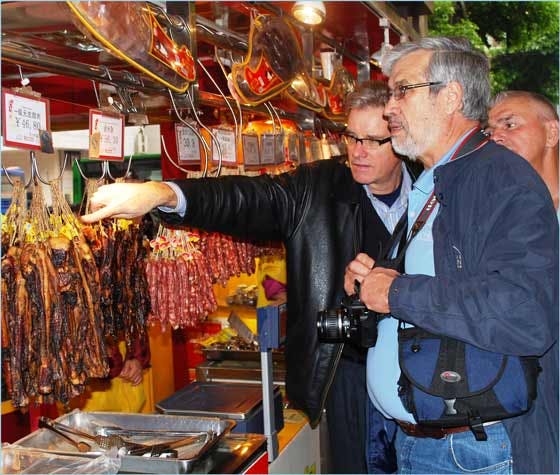Market Education Program Kicks off in Korea, Southern China
Published: Mar 13, 2012
Fifteen representatives of USMEF member organizations are visiting South Korea and southern China this week as part of the annual USMEF Market Education Program. In Korea, these pork, beef, corn and soybean producers got a firsthand look at USMEF marketing efforts in the retail, foodservice, processing and distribution sectors. They also had an opportunity to learn more about the benefits of the Korea-U.S. Free Trade Agreement, which is set to take effect March 15.

Roger Knoblock, a hog producer and cattle feeder from Lester, Iowa, is participating on behalf of the Iowa Corn Promotion Board. He was pleased with the level of success U.S. pork and beef have achieved in Korea, but recognizes that competition in the market is formidable. According to the Global Trade Atlas, the U.S. is one of 19 countries exporting pork to South Korea so far this year.
“Right now this market is performing very well, even with all the competition we face here,” Knoblock said. “But the promotional work that’s being done in retail stores and restaurants – I’m very impressed. The USMEF-Korea staff has done an excellent job, and I don’t know what we would do without them.”
Chris Abbott, a cattle rancher from Cherry County, Neb., and a member of the Nebraska Beef Council board of directors, echoed these sentiments.
“We need to hustle just to keep up with our competitors when it comes to marketing and promotion,” Abbott said. “And to come over here and see the work that USMEF is doing, that’s been a real eye-opener for me.”
The group ended its time in Korea with a dinner at Goo STK Itaewon, a popular restaurant in Seoul that features dry-aged U.S. steaks.
“I started using dry-aged U.S. beef at a time when everyone in Korea was against that idea,” said restaurant owner Ian Kim. “Now, interest in dry-aging is really taking off and I’m very happy to share my experience with others here in Korea.”
On Tuesday, team members flew to Guangzhou, China, a major commercial center in southern China, where they visited a local wet market and saw U.S. pork featured in the city’s retail and restaurant sectors.
“The restaurants and vendors who feature U.S. pork appear to be doing a great job with the product,” said Roy Henry, a pork producer from Longford, Kan., and member of the National Pork Board. “Even though China is the world’s biggest pork producer, there are still great opportunities here because of the tremendous number of consumers. This is a particularly good market for some of our underutilized cuts and variety meats that aren’t needed at home, and that makes for a great partnership if we can make it work.”
“It’s pretty obvious down here (in southern China), that pork is king,” added Dave Harrington, a pork producer from St. Paul, Neb., and past president of the Nebraska pork Producers Association. “There’s a tremendous amount of pork consumed in this area, and as the consumers’ lifestyle improves I think it will open up opportunities for higher-quality cuts in addition to the items we’ve traditionally exported here.”
On Wednesday the group will visit more foodservice and retail outlets in Guangzhou before moving on to Shenzhen City and Hong Kong.
